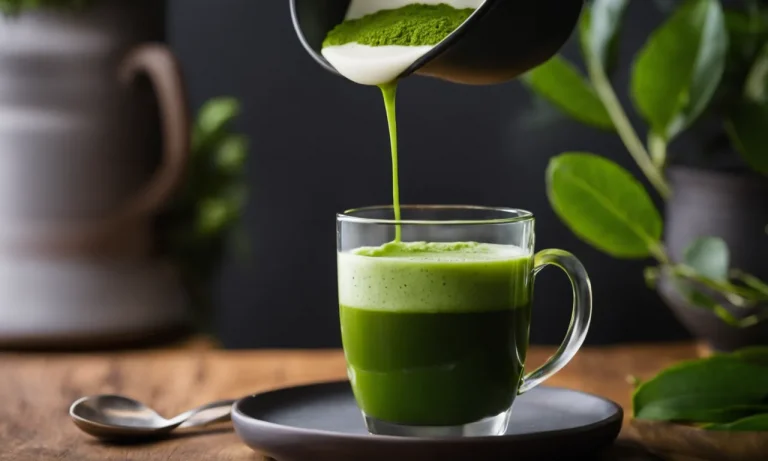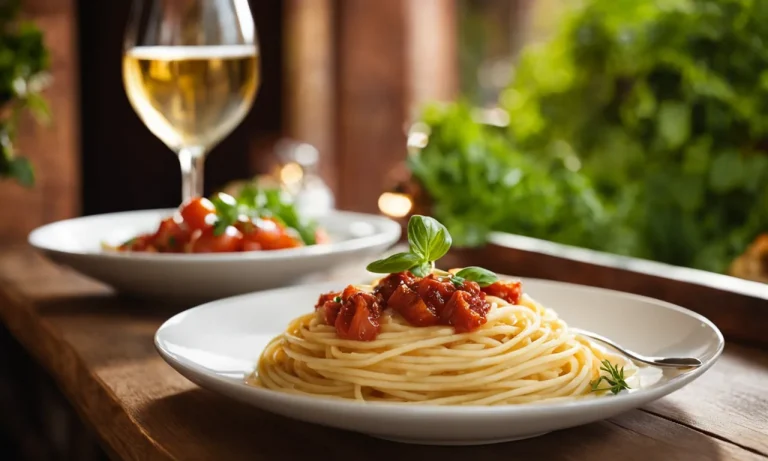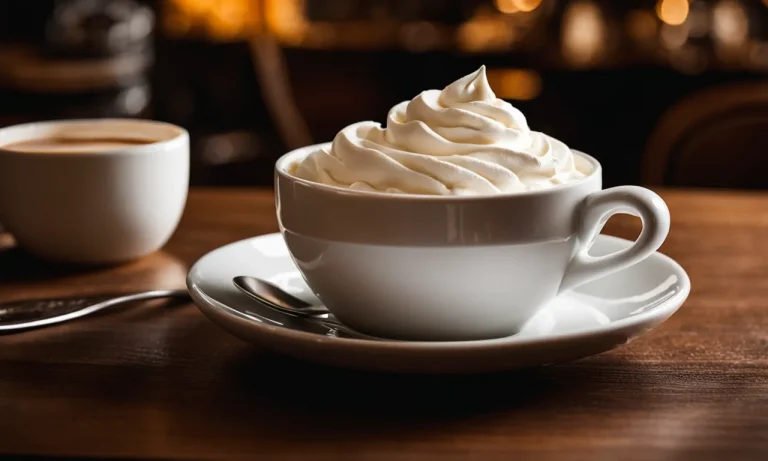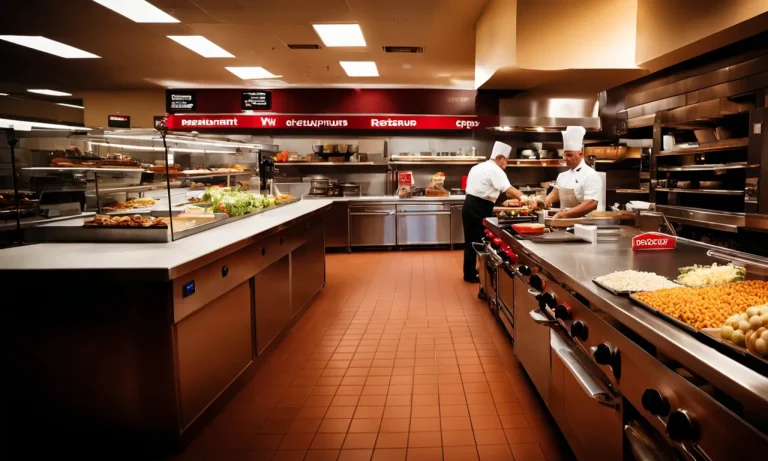Matcha lattes have become an increasingly popular drink option at coffee shops like Starbucks in recent years. But are they worth the hype and the price? Starbucks offers a signature Matcha Green Tea Latte made with premium matcha powder from Japan.
However, some matcha purists argue that the drink is far inferior to an authentic matcha prepared traditionally. Here’s a quick take: The Starbucks matcha latte offers a convenient, consistent way to enjoy matcha but lacks the depth of flavor and experience of high-quality ceremonial grade matcha whisked fresh.
In this in-depth guide, we’ll explore the key factors that determine the quality and taste of a matcha latte. We’ll compare the Starbucks version to more traditional preparation methods and premium matcha quality.
Read on to learn all about the origins of matcha, how it’s produced, and whether the Starbucks matcha latte lives up to the hype.
What is Matcha?
Matcha is a type of powdered green tea that has gained popularity in recent years for its unique flavor and potential health benefits. It is a staple in traditional Japanese tea ceremonies and is known for its vibrant green color and earthy taste.
Unlike regular green tea, which is steeped and discarded, matcha is made by grinding the whole tea leaves into a fine powder, which is then whisked into hot water or milk to create a frothy beverage.
Basic Definition and History
Matcha has a rich history that dates back over 800 years. The tea leaves used to make matcha are grown in the shade, which increases their chlorophyll content and gives them their vibrant green color. The leaves are then harvested, steamed, dried, and ground into a fine powder.
Matcha has been an integral part of Japanese culture for centuries and is often used in tea ceremonies as a symbol of hospitality and respect.
How Authentic Matcha is Produced
The process of producing authentic matcha is meticulous and time-consuming. It starts with selecting the right tea leaves, usually from the first harvest of the year. These leaves are then steamed to stop oxidation, dried, and carefully ground into a fine powder using traditional granite stone mills.
This traditional method ensures that the matcha retains its vibrant green color and rich flavor.
Ceremonial Grade vs. Culinary Grade
There are two main grades of matcha available: ceremonial grade and culinary grade. Ceremonial grade matcha is made from the youngest and most tender leaves, resulting in a smoother and sweeter flavor. It is also more expensive due to its higher quality.
Culinary grade matcha, on the other hand, is made from slightly older leaves and is often used in cooking and baking. While it may not have the same delicate flavor as ceremonial grade matcha, it is still a great option for incorporating matcha into various recipes.
Key Factors That Impact Matcha Quality
When it comes to the quality of matcha, several key factors play a significant role. These factors determine the taste, aroma, and overall experience of enjoying a matcha latte at Starbucks or any other establishment. Let’s take a closer look at these factors:
Origin and Growing Region
The origin and growing region of matcha leaves greatly impact their quality. Matcha is traditionally grown in Japan, where the climate, soil conditions, and traditional cultivation techniques contribute to the unique flavor profile of Japanese matcha.
The most highly regarded matcha is often sourced from regions such as Uji, Nishio, or Shizuoka. These regions have a long history of matcha cultivation and are known for producing high-quality leaves.
Shade-Grown Method
The shade-grown method is a crucial step in matcha production that directly affects its quality. Matcha leaves are shaded from direct sunlight for several weeks before harvest. This process increases the chlorophyll content in the leaves, giving matcha its vibrant green color and enhancing its flavor.
The shade-grown method also reduces the bitterness and astringency often associated with lower-quality matcha.
Harvesting and Processing
The timing of the harvest and the processing methods used are essential for maintaining the quality of matcha. Matcha leaves are typically hand-picked, selecting only the youngest and most tender leaves. This ensures that the matcha has a smoother and more delicate taste.
After harvesting, the leaves are steamed, dried, and ground into a fine powder. The careful processing preserves the natural flavors and nutrients of the leaves, resulting in a high-quality matcha.
Storage and Freshness
Proper storage and freshness are crucial for maintaining the quality of matcha. Matcha should be stored in an airtight container, away from light, heat, and moisture. Exposure to these elements can cause the matcha to lose its flavor and become stale.
It is recommended to consume matcha within a few months of opening to ensure maximum freshness. Starbucks and other reputable establishments often prioritize freshness by regularly rotating their matcha stock and ensuring proper storage conditions.
For more information and in-depth insights on matcha quality, you can visit websites such as Ito En or Matcha Source.
How Starbucks Makes its Matcha Lattes
Matcha lattes have become increasingly popular in recent years, and Starbucks is one of the go-to places for this refreshing and energizing beverage. But have you ever wondered how Starbucks creates its matcha lattes? Let’s take a closer look at the process.
Type of Matcha Used
Starbucks uses a high-quality matcha powder to create its matcha lattes. Matcha is a powdered green tea that is traditionally grown and processed in Japan. It is made from shade-grown tea leaves that are finely ground to create a vibrant green powder.
The flavor of matcha can vary depending on the quality and origin of the tea leaves used. Starbucks carefully selects its matcha to ensure a smooth and balanced flavor profile for its lattes.
Preparation Method
When making a matcha latte, Starbucks baristas start by scooping the appropriate amount of matcha powder into a cup. They then add a small amount of hot water and whisk the mixture vigorously to create a smooth and frothy base.
Next, steamed milk is added to the matcha mixture, creating a creamy and indulgent beverage. The ratio of matcha to milk can be customized based on personal preference.
Customizations Offered
One of the great things about Starbucks is the ability to customize your drink to suit your taste buds. When it comes to matcha lattes, Starbucks offers a range of customizations. Customers can choose the type of milk they prefer, such as whole milk, almond milk, or soy milk.
They can also request additional sweeteners, like vanilla syrup or honey, to enhance the flavor. For those who prefer a stronger matcha taste, Starbucks offers the option to add extra matcha powder.
So, the next time you find yourself craving a matcha latte, you can trust that Starbucks uses high-quality matcha powder and a carefully crafted preparation method to create a delicious and customizable beverage. Give it a try and see if the matcha latte at Starbucks lives up to your expectations!
Comparing Starbucks Matcha to Authentic Preparation
Matcha lattes have become increasingly popular, and Starbucks is one of the go-to places for many people to get their matcha fix. However, some may wonder if the matcha latte at Starbucks is actually good when compared to the authentic preparation.
Let’s take a closer look at the key factors that differentiate the two.
Flavor Profile
When it comes to the flavor profile, there is a noticeable difference between Starbucks matcha latte and the authentic preparation. Authentic matcha is known for its vibrant green color and rich, earthy taste. The flavor is often described as grassy, vegetal, and slightly bitter.
On the other hand, Starbucks matcha latte tends to have a smoother and sweeter taste, which some people might prefer. It’s important to note that the flavor can vary depending on personal preference, so it’s worth trying both to see which one you prefer.
Mouthfeel and Texture
The mouthfeel and texture of a matcha latte can greatly impact the overall drinking experience. Authentic matcha is traditionally made by whisking powdered matcha with hot water, creating a frothy and velvety texture.
This texture enhances the drinking experience and allows you to fully appreciate the flavors. On the other hand, Starbucks matcha latte tends to have a creamier and smoother texture, thanks to the addition of milk.
Some people might prefer this creamier texture, while others might prefer the traditional frothy texture.
Caffeine Content
When it comes to caffeine content, matcha is known for providing a steady release of energy without the jitters often associated with coffee. However, the caffeine content can vary depending on the grade and preparation method.
Authentic matcha typically contains higher levels of caffeine compared to Starbucks matcha latte. This is because Starbucks uses a pre-packaged matcha powder mix, which may contain less matcha and more additives.
If you’re looking for a stronger caffeine boost, authentic matcha might be the way to go.
Cost Comparison
Cost is another factor to consider when comparing Starbucks matcha to the authentic preparation. Starbucks matcha latte can be quite expensive, especially if you opt for a larger size or additional flavorings.
On the other hand, purchasing high-quality matcha powder and preparing it at home can be more cost-effective in the long run. Additionally, by preparing matcha at home, you have more control over the ingredients and can ensure a higher quality product.
Matcha Latte Recipe with Ceremonial Grade Matcha
Are you a matcha lover who wants to recreate the delicious matcha latte experience at home? Look no further! Here’s a simple and easy-to-follow recipe for a matcha latte using ceremonial grade matcha.
Ingredients Needed:
- 1 teaspoon of ceremonial grade matcha powder
- 1 cup of milk (dairy or plant-based)
- 1 teaspoon of sweetener (optional)
Step-by-Step Instructions:
1. Start by heating the milk in a small saucepan over medium heat. Be careful not to let it boil.
2. In a separate bowl, whisk the matcha powder with a small amount of hot water to create a smooth paste.
3. Pour the milk into the bowl with the matcha paste and whisk vigorously until well combined.
4. If desired, add a teaspoon of sweetener and continue whisking until the sweetener is fully dissolved.
5. Pour the matcha latte into a mug and enjoy!
Pro Tips for Frothy Foam:
If you want to achieve that creamy and frothy foam on top of your matcha latte, here are a few tips:
- Use a bamboo whisk or a handheld milk frother to whisk the matcha and milk together. This will help create a smooth and frothy texture.
- Make sure to whisk vigorously and in a zigzag motion to incorporate air into the mixture.
- If you prefer a sweeter latte, add a teaspoon of sweetener before whisking to ensure it blends evenly.
By following this recipe and using high-quality ceremonial grade matcha, you can enjoy a delicious matcha latte right in the comfort of your own home. So go ahead, give it a try and savor the rich and earthy flavors of matcha!
Conclusion
While the Starbucks Matcha Green Tea Latte provides an accessible introduction to matcha, there are clear trade-offs versus a traditional ceremonial grade matcha preparation. Factors like freshness, quality of the matcha powder, and preparation method impact the flavor profile and overall experience.
For matcha purists seeking an authentic, high quality experience, preparing matcha with ceremonial grade powder according to traditional methods is recommended. However, for a convenient matcha latte on-the-go, Starbucks offers a consistent product.
Just don’t expect the depth of flavor or wholesome experience of fresh matcha whisked in the traditional manner.






